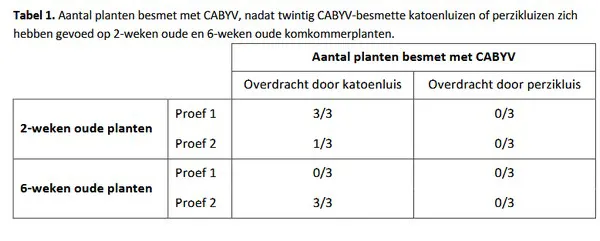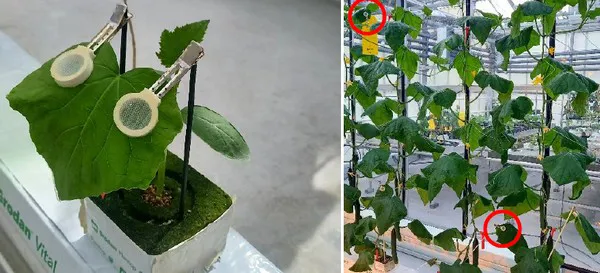A new virus was found in Dutch cucumber crops in 2021: the Cucurbit aphid-borne yellows virus (CABYV). The virus also turned up in Belgium. Much is still unclear about the virus. For instance, what is the incubation period, and what exactly are the spreaders of the virus? The Control in Food & Flowers Foundation carried out various greenhouse trials to gain more insight into the characteristics of the virus.
Answers to the following questions were sought during greenhouse trials:
- What is the incubation period of CABYV?
- How long can CABYV-infected aphids transmit the virus to uninfected plants?
- Can the virus also be transmitted by winged aphids?
- Can the offspring of CABYV-infected aphids also transmit the virus?
- Can CABYV also be transmitted by whitefly?
Incubation period and aphid species
To determine the incubation period, a study was conducted with two-week-old cucumber plants and six-week-old cucumber plants. Both cotton aphid and peach aphid were looked at. In a table, the researchers show the results.

Table 1: Number of plants infected with CABYV after 20 CABYV-infected cotton aphids or peach aphids fed on 2-week-old and 6-week-old cucumber plants. First column, top: 2-week-old plants, bottom: 6-week-old plants. Second column: Test 1, Test 2. Third column: transmission by cotton aphid. Fourth column: transmission by peach aphid.
The conclusion is that peach aphid did not transmit the virus in the trial. Greenhouse whitefly was also ruled out by the researchers. The cotton aphid does transmit the virus. When transmitted on two-week-old plants, the incubation period was about two to three weeks, with symptoms of the virus first appearing in the lower parts of the plant. In six-week-old plants, the incubation period is longer (five to six weeks).
During an initial trial of six-week-old plants that was stopped after four weeks, no symptoms were visible at that time. In a second trial, in which the plants were left for eight weeks, they were. In that case, symptoms were visible higher up in the plant, on the inoculated leaves and young shoots. When re-sampling the plants after six weeks, in each of the three plants, CABYV was still detected (as shown in Table 1 above).

Persistence of virus in aphids
Viruses transmitted by insects can be persistent or non-persistent. Viruses transmitted in a non-persistent manner often do not get beyond the insect's mouthparts or foregut and remain infectious for only a few hours after being ingested by the insect. Viruses that are persistently transmitted move throughout the insect's digestive tract and remain infectious for several days or weeks after ingestion or even throughout the insect's lifetime.
It is not yet known whether CABYV is transmitted persistently or non-persistently and how long aphids remain infectious after becoming infected with CABYV. Therefore, the study investigated how long cotton aphids are able to transmit CABYV to clean plants after ingesting the virus.
In an experiment, the researchers showed that cotton aphids can transfer the virus to other plants at least three weeks after ingesting CABYV. In another study, the researchers showed that aphids do not transmit the virus to their offspring.
Transmission by winged cotton aphid
It is known that cotton aphid is an important vector for CABYV. However, it is not yet known whether, besides non-winged cotton aphid, winged cotton aphid can also transmit the virus. If
winged aphids can also transmit the virus, this poses a greater risk of the introduction of CABYV by outside invasion. In addition, winged aphids can travel greater distances within the greenhouse, allowing the virus to spread more quickly. A trial tested whether winged cotton aphids are capable of transmitting CABYV. The trial demonstrated that they do.
View the whole report of the study, which was made possible by Glastuinbouw Nederland, Stichting Kennis in je Kas (KijK), and the crop cooperative Komkommer, here.
